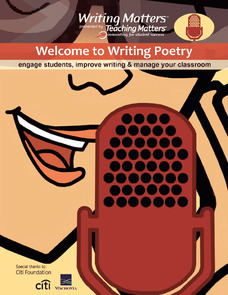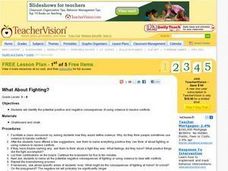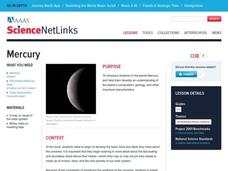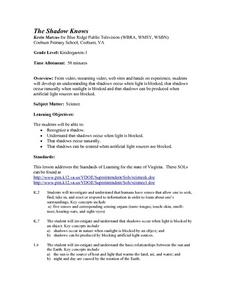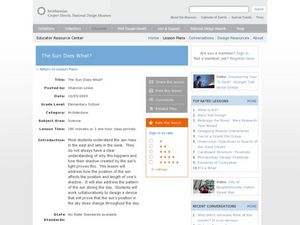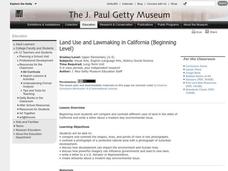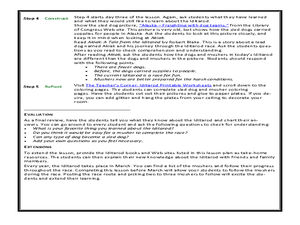Teaching Matters
Welcome to Writing Poetry
Your pupils are poets, and now they'll be able to show it with the exercises in this packet. The lessons, designed for beginner, intermediate, and experienced poets, not only feature a variety of poetic forms, but take...
Curated OER
The Moon
Students design and build an ideal lunar settlement. In this astronomy lesson plan, students identify the key features of the moon. They compare its environmental condition with the Earth's.
Curated OER
Estuary Interviews
Young scholars role play as newscasters to highlight the lives of estuary animals. In this estuary animal instructional activity, students watch local new shows to examine how interviews take place. They research the lives of animals...
Curated OER
What About Fighting?
What are the positive and negative consequences of violence? Elementary and middle schoolers discuss how some see violence as the answer to resolving conflicts. They identify the positive and negative aspects to using violence, and ask...
Curated OER
What's So Bad or Good About Conflict?
Learners of all ages discuss how conflict can be negative and positive. First, they create a class bulletin board about conflict, and provide their thoughts and connotations surrounding the word. In a class discussion, they ask questions...
Curated OER
Why Do We Have Night?
Young scholars engage in a fun, creative way to discover how the Earth moves. This lesson helps students explain why there is day and night. It can also create curiosity to further study the solar system and eclipses!
Curated OER
Can Worms See?
Second graders discuss the previously created worm compost and the importance of living creatures to the Environment. In this worm lesson, 2nd graders observe worms and record their sensitivity to light. Students design a petri...
Curated OER
Mercury
Students study the planet Mercury and develop an understanding of the planet's composition, geology, and other important characteristics. They explore a Web resource on the planet Mercury which is the central focus of this lesson plan.
Curated OER
Panther Trivia Pursuit
Sixth graders design trivia game about panthers. In this panther trivia game lesson plan, 6th graders use the Internet to research interesting information about panthers, write the facts on note cards, and create a game based on...
Laboratory for Atmospheric and Space Physics
Charting the Progress of New Horizons
In 2006, New Horizons began its mission to fly to Pluto. As it continues its journey, scholars track its progress with the help of an informative website, all the while reinforcing measurement concepts with the construction of a scaled...
Curated OER
The Shadow Knows - Creating Shadows
Young learners recognize a shadow and witness how shadows occur when light is blocked. They access streamed video, standard video, and websites in order to engage in their study of how light is naturally blocked to create shadows. An...
Curated OER
Tie Dye Eggs
Students create "tie-dye" easter eggs in this easy elementary school lesson. Materials needed include paper towels, food coloring, eggs, and rubber gloves. This Easter lesson can be accomplished in 30 minutes with extra time needed for...
Curated OER
Van Gogh's Sunflowers
Pupils create replicas of Vincent Van Gogh's Sunflowers using construction paper, tissue paper, glue, and scissors in this art lesson for the elementary classroom. The flowers can then be displayed in the room as a class bulletin board.
Curated OER
Heart Shaped Mice
Students create mice using heart shapes, construction paper, yarn, markers, scissors, and glue in this Art activity for the early-elementary classroom. The activity is an excellent alternative for use during the Valentine's Day season.
Curated OER
Stand Up Bunny
Students create "stand-up bunnies" for classroom display in this early-elementary Art lesson ideal for the spring months. A bunny template and design ideas are included to aid in the teaching process of this fun and quick lesson.
Curated OER
Wiggly Spiders
Young scholars create "wiggly spiders" using black paint, construction paper, yarn, and their hands in this fun, messy, art lesson for the early elementary classroom. An ideal lesson for the Halloween holiday or for a lesson/unit on...
Curated OER
The Sun Does What?
Young scholars examine why the sun rises in the east and sets in the west. In this sun lesson, students explore the sunset and shadows. Young scholars prove that the sun's position changes during the day. Students investigate what causes...
Curated OER
Cloud Fun
Students observe cumulus clouds. In this weather lesson, students go outside to look at cumulus clouds and observe what the weather is like when they find these types of clouds. They create a cumulus cloud in an art project and complete...
Curated OER
Australian Aborigine Lizard Painting
Students become familiar with Australian "dot paintings." In this Australian Aboriginal Lizard painting lesson, students make illustration of three types of lizards and complete pictures using "dot painting." Students recognize the...
Curated OER
Junk Sort
Students analyze objects by one or more attributes. In this sorting lesson, students use manipulatives and string or yarn to create a sorting game. Students read books and items from the classroom to sort.
Curated OER
Sunspots
Students examine what a sunspot is and how it is produced. In this sun lesson students locate and measure sunspots then view them through a camera.
Curated OER
Land Use and Lawmaking in California
Students investigate the laws of using land. In this California Government lesson, students examine the many uses of land in California and find an environmental issue they care about. Students write a letter to a politician...
Curated OER
The Iditarod: The Last Great Race
Students investigate the Iditarod. In this last great race lesson, students explore and research the Iditarod race which takes place in Alaska. Students explore a variety of websites and images to gather background information. A...
Curated OER
Sunlight and Warm Air
Students examine the different ways heat can be felt. For this radiation and conduction lesson, students recognize that the sun radiates heat. Students conduct three experiments to find how the sun warms the Earth and how that heat...


